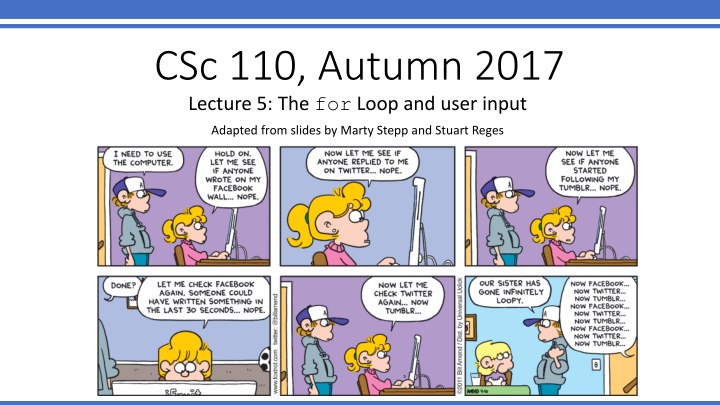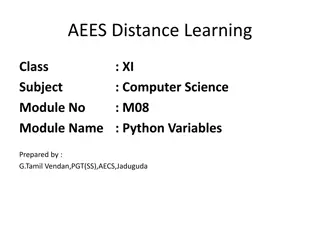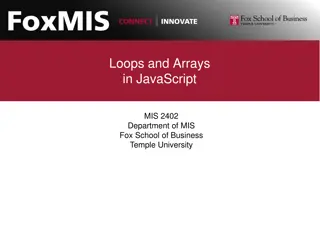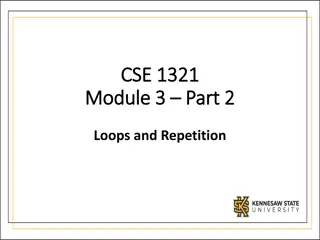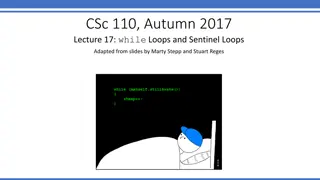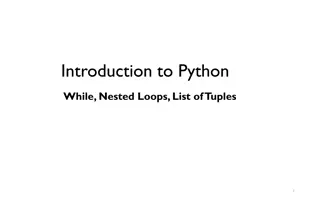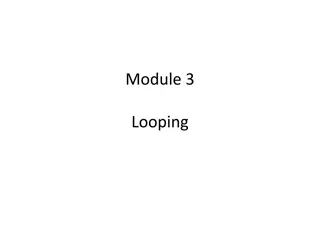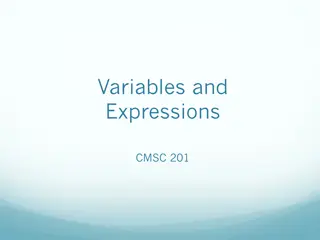Using Variables and For Loops in Python
Learn how to declare and assign variables, use variables in expressions, and understand the concepts of assignment and algebra in Python programming. Explore how to improve programs using variables and repetition with for loops. Find out how to eliminate redundancy in code by leveraging the power of for loops to perform tasks iteratively.
Download Presentation

Please find below an Image/Link to download the presentation.
The content on the website is provided AS IS for your information and personal use only. It may not be sold, licensed, or shared on other websites without obtaining consent from the author.If you encounter any issues during the download, it is possible that the publisher has removed the file from their server.
You are allowed to download the files provided on this website for personal or commercial use, subject to the condition that they are used lawfully. All files are the property of their respective owners.
The content on the website is provided AS IS for your information and personal use only. It may not be sold, licensed, or shared on other websites without obtaining consent from the author.
E N D
Presentation Transcript
CSc 110, Autumn 2017 Lecture 5: The for Loop and user input Adapted from slides by Marty Stepp and Stuart Reges
Declaration and assignment variable declaration and assignment: Sets aside memory for storing a value and stores a value into a variable. Variables must be declared before they can be used. The value can be an expression; the variable stores its result. Syntax: name = expression zipcode 90210 zipcode = 90210 myGPA = 1.0 + 2.25 myGPA 3.25
Using variables Once given a value, a variable can be used in expressions: x = 3 # x is 3 y = 5 * x - 1 # now y is 14 You can assign a value more than once: x x 3 11 x = 3 # 3 here x = 4 + 7 # now x is 11
Assignment and algebra Assignment uses = , but it is not an algebraic equation. = means, "store the value at right in variable at left" The right side expression is evaluated first, and then its result is stored in the variable at left. What happens here? x x 3 5 x = 3 x = x + 2 # ???
Receipt question Improve the receipt program using variables. def main(): # Calculate total owed, assuming 8% tax / 15% tip print("Subtotal:") print(38 + 40 + 30) print("Tax:") print((38 + 40 + 30) * .08) print("Tip:") print((38 + 40 + 30) * .15) print("Total:") print(38 + 40 + 30 + (38 + 40 + 30) * .15 + (38 + 40 + 30) * .08)
Getting rid of repetition Functions Variables String Multiplication Allows you to print multiple occurrences of the same string without typing them all out print("meow" * 3) # meowmeowmeow What if you want to repeat function calls?
Repetition with for loops So far, repeating an action results in redundant code: make_batter() bake_cookies() bake_cookies() bake_cookies() bake_cookies() bake_cookies() frost_cookies() Python's for loop statement performs a task many times. mix_batter() for i in range(1, 6): # repeat 5 times bake_cookies() frost_cookies()
for loop syntax for variable in range (start, stop): statement statement ... statement header body Set the variable equal to the start value Repeat the following: Check if the variable is less than the stop. If not, stop. Execute the statements. Increase the variable's value by 1.
Control structures Control structure: a programming construct that affects the flow of a program's execution Controlled code may include one or more statements The for loop is an example of a looping control structure
Repetition over a range print("1 squared =", 1 * 1) print("2 squared =", 2 * 2) print("3 squared =", 3 * 3) print("4 squared =", 4 * 4) print("5 squared =", 5 * 5) print("6 squared =", 6 * 6) Intuition: "I want to print a line for each number from 1 to 6" The for loop does exactly that! for i in range(1, 7): print(i, "squared = ", i * i) "For each integer i from 1 through 6, print ..."
Loop walkthrough for i in range(1, 5): print(i, "squared =", i * i) print("Whoo!") Output: 1 squared = 1 2 squared = 4 3 squared = 9 4 squared = 16 Whoo!
Multi-line loop body print("+----+") for i in range(1, 4): print("\\ /") print("/ \\") print("+----+") Output: +----+ \ / / \ \ / / \ \ / / \ +----+
Expressions for counter high_temp = 5 for i in range(-3, high_temp // 2 + 1): print(i * 1.8 + 32) Output: 26.6 28.4 30.2 32.0 33.8 35.6
Rocket Exercise Write a method that produces the following output: T-minus 10, 9, 8, 7, 6, 5, 4, 3, 2, 1, blastoff! The end.
print (' ', end='') Adding ,end='' allows you to print without moving to the next line allows you to print partial messages on the same line high_temp = 5 for i in range(-3, high_temp // 2 + 1): print(i * 1.8 + 32, end=' ') Output: 26.6 28.4 30.2 32.0 33.8 35.6 Either concatenate ' ' to separate the numbers or set end=' '
Changing step size Add a third number to the end of range, this is the step size A negative number will count down instead of up print("T-minus ") for i in range(10, 0, -1): print(str(i) + ", ", end="") print("blastoff!") print("The end.") Output: T-minus 10, 9, 8, 7, 6, 5, 4, 3, 2, 1, blastoff! The end.
Constants constant: A fixed value visible to the whole program. value should only be set only at declaration; shouldn't be reassigned Syntax: Just like declaring a normal variable: name = value name is usually in ALL_UPPER_CASE Examples: DAYS_IN_WEEK = 7 INTEREST_RATE = 3.5 SSN = 658234569
Constants and figures Consider the task of drawing the following scalable figure: +/\/\/\/\/\/\/\/\/\/\+ | | | | | | | | | | +/\/\/\/\/\/\/\/\/\/\+ Multiples of 5 occur many times +/\/\/\/\+ | | | | +/\/\/\/\+ The same figure at size 2
Constant tables SIZE = ... What equation would cause the code to print: 2 7 12 17 22 To see patterns, make a table of SIZE and the numbers. Each time SIZE goes up by 1, the number should go up by 5. But SIZE * 5 is too great by 3, so we subtract 3. number to print 5 * SIZE SIZE 5 * SIZE - 3 1 2 5 2 2 7 10 7 3 12 15 12 4 17 20 17 22 5 22 25
Constant tables question What equation would cause the code to print: 17 13 9 5 1 Let's create the constant table together. Each time SIZE goes up 1, the number printed should ... But this multiple is off by a margin of ... number to print SIZE -4 * SIZE -4 * SIZE -4 * SIZE+ 21 1 17 -4 -4 17 2 13 -8 -8 13 3 9 -12 -12 9 4 5 -16 -16 5 5 1 -20 -20 1
Interactive programs interactive program: Reads input from the console. While the program runs, it asks the user to type input. The input typed by the user is stored in variables in the code. Can be tricky; users are unpredictable and misbehave. But interactive programs have more interesting behavior.
input input: An function that can read input from the user. Using an input object to read console input: name = input(prompt) Example: name = input("type your name: ") The variable name will store the value the user typed in
input example def main(): age = input("How old are you? ") years = 65 - age print(years, " years until retirement!") age 29 Console (user input underlined): How old are you? 29 Traceback (most recent call last): File "<pyshell#13>", line 1, in <module> print(65 - age) TypeError: unsupported operand type(s) for -: 'int' and 'str'
input example def main(): age = int(input("How old are you? ")) years = 65 - age print(years, "years until retirement!") age 29 years 36 Console (user input underlined): 29 How old are you? 36 years until retirement!
